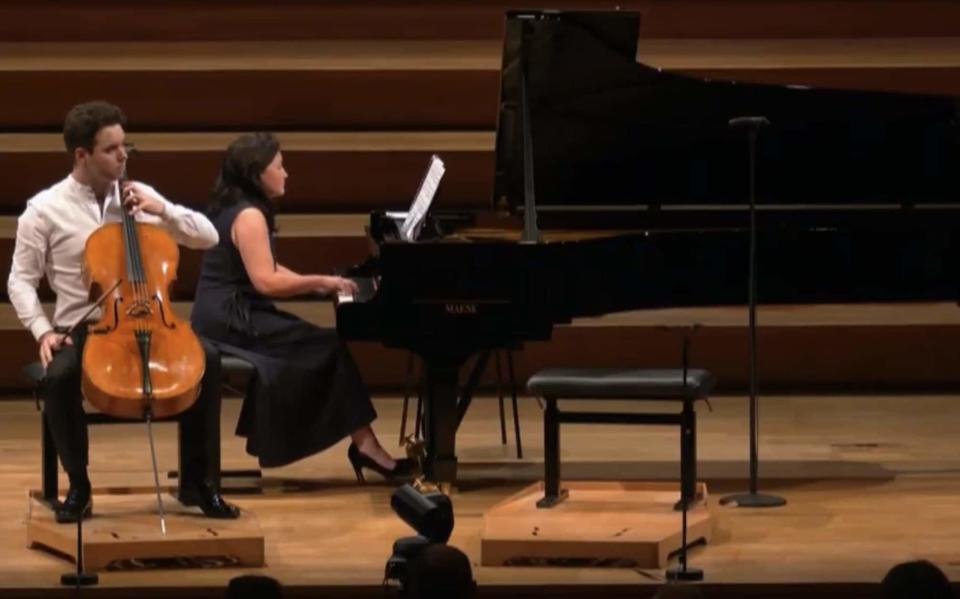A Holocaust survivor will be reunited with her father’s cello more than eighty years after the renowned Jewish composer was murdered by the Nazis.
Pál Hermann, the distinguished Hungarian-born cellist and composer, fled his home in Berlin to hiding in France but was found by secret police and sent to a death camp in 1944, aged 42.
His daughter, Cornelia Hermann, who was just seven years old when he died, never lost hope of finding the instrument which the family had stolen back after his capture, but were later forced to sell when they fell on hard times.
According to a new book by Dr Kate Kennedy, the instrument was “the nearest she could get to glimpsing her father and hearing his voice”.
Hermann had been given the 18th-century cello by a wealthy Dutch couple after he damaged his own in an act of flamboyance, using it as a dance partner at his patrons’ London townhouse in 1928.
The replacement cello, made by Nicolò Gagliano, an Italian luthier, was rescued in a daredevil burglary by Hermann’s relatives after his capture, but was later sold when the family needed money for Cornelia’s studies.

Dr Kennedy discovered that it had been played by a Carl Herzbruch in Cologne in the 1960s but subsequently disappeared.
The author came across Hermann’s story when writing her book Cello: A Journey Through Silence to Sound, and issued an appeal on social media for help.
She noted that the cello was recognisable by the burnt Latin inscription on its ribs which reads: “Ego Sum Anima Musica [I am the soul of music]”.
She wrote that she “would love to have his concerto performed on it, and its owner know its true identity”.
Chance rediscovery
Jian Wang, a cellist, read the book and happened to recognise Hermann’s cello from his time on the Queen Elizabeth cello competition jury, when he had seen young musician Sam Lucas play the instrument in 2022.
Mr Wang tracked the cello to the Robert Schumann Hochschule in Dusseldorf, where it had been loaned to star student Mr Lucas, who was unaware of the instrument’s history.
Ms Hermann, 92, is said to be delighted that the cello has been located. She will have the opportunity to see the instrument being played at the Wigmore Hall in London on Sept 29.
A few years ago, Ms Hermann found a manuscript of a cello concerto written by her father among family papers. It has now been edited, recorded and a section of it will be played by Mr Lucas on the very cello on which it was composed.
Hermann was born in Budapest to middle-class Jewish parents in 1902. His family rarely attended synagogue and encouraged him to pursue his career as a cellist.
In her book, Kennedy wrote: “Jews were so integrated in his home town of Budapest that singling them out as different would have been absurd. And yet, Pál’s Jewishness would come to define him.”
Hermann made his breakthrough performing Kodály’s Sonata for Solo Cello in Vienna at the invitation of the eminent composer Arnold Schoenberg, and moved to Berlin in 1923 to pursue music.
Critics at the time had labelled him the “already world-famous Hungarian cello genius” and he had attracted comparisons to Pablo Casals.
Patrons in London
It was in London in 1928 that Jaap de Graaff and Louise Bachiene, arts philanthropists, took a shine to Hermann.
The Dutch couple replaced his wrecked cello with the Gagliano through an extended loan agreement, though both parties knew he would not be able to pay it back.
When Hermann embarked on a recital tour of the Netherlands, the couple encouraged their musical niece, Ada Weevers, to hear him play in Amsterdam.


The pair fell in love and married in Amersfoort, near Utrecht, in 1931, before moving to Berlin where they lived a fulfilled life among kindred spirits.
Ms Hermann, the couple’s daughter, was born in 1932, but the family fled to the Netherlands a year later when Hitler came to power.
Ms Weevers died suddenly aged just 25 after reportedly becoming trapped in a gully while swimming in the North Sea.
Hiding in south of France
Ms Hermann was left with her non-Jewish family while Mr Hermann moved first to Brussels and then Paris before hiding in the south of France in 1939.
By then, he had changed his name to De Cotigny and evaded the Nazis by living inconspicuously in a farmhouse owned by the Graaff-Bachiene family near Toulouse.
Becoming restless and needing income, Mr Hermann moved to the city where he taught music and played in concerts before he was rounded up by a street razzia in Toulouse in February 1944.
He was held at Drancy internment camp before being herded into cattle trucks as part of Convoy 73 on May 15 1944.
Dr Kennedy said the train was destined for the “Fort of Death” near Kaunas in Lithuania – a place of mass murder of Jews from around Europe – and no record has been found of Hermann’s fate.
She added: “If the facts of his life had been different, his work would be well known, programmed in chamber music festivals and recitals alongside Bartók or Kodály.
“But instead, his work is only now being rediscovered, after a seventy-year silence.”
